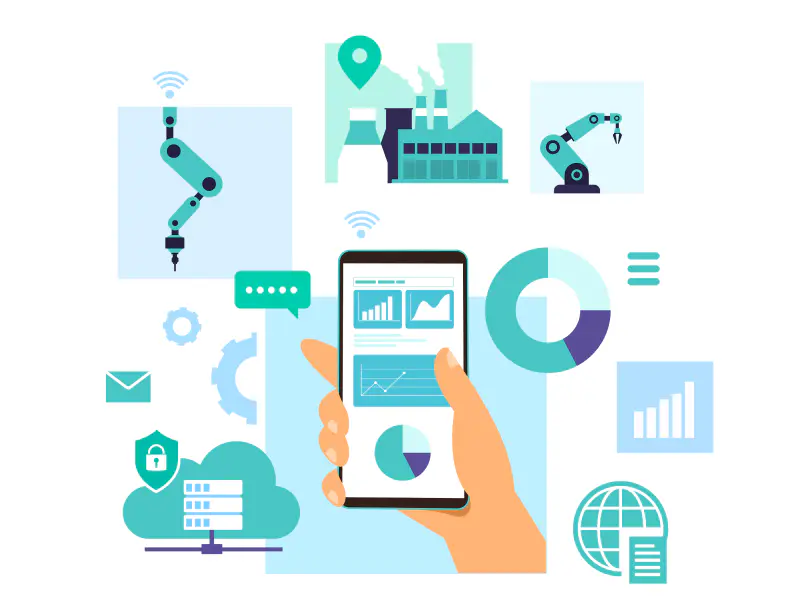
By connecting the devices to smart networks, the Internet of Things (IoT) ensures that they effectively communicate and work together.IoT focuses on smaller segmented systems, instead of relying on large, centralized systems. This significantly reduces the complexity of management, upgrades, and maintenance.
Industrial Internet of Things (IIoT) is transforming operations in manufacturing with IoT analytics playing a key role. Manufacturers rely on data to assess performance, identify bottlenecks, and make informed decisions to boost efficiency. Artificial intelligence (AI) can further automate this process, enhancing productivity.
But IIoT needs meticulous planning for its execution. Use of modern technologies and following the current trends is important in staying competitive relevance in 2025. The latest IIoT trends in 2025 are given below:
Connectivity plays a crucial role in the success of IIoT. The amount of data shared at once by devices is a critical factor on the speed and efficiency of the whole system. The success of real time applications and edge computing highly depends on network speed. However, if data transmission doesn’t require maximum speed, extremely high bandwidth may not be necessary. Evaluating the needs of the manufacturing business is essential to select the most suitable network solutions.
Breakdowns in manufacturing centers can result in significant costs. Predictive maintenance based on artificial intelligence offers a solution for saving millions for industries. However, the functioning of industrial machine learning algorithms rely on the data of machinery that they are evaluating. IIoT sensors collect data across a network of machines. This data helps analyze when maintenance is needed and the specific machine on which it needs to be done before any probable breakdown.
Real-time location systems (RTLS) that use wireless technologies like Wi-Fi, BLE beacons, UWB, and RFID, allow accurate tracking of factory floor items. These systems monitor progress throughout the production process, ensuring quality assurance and generating valuable data. This data can improve digital twin applications as it also provides insight into operational efficiency and performance.
IIoT energy optimization sensors allow operators to understand and monitor the electrical state and use of devices and machines within a factory in order to enable fine-tuned control as well as facilitate automated energy optimization. Smarter energy management not only cuts costs but also supports sustainability goals.
Edge computing is one of the major trends in Industrial IoT, which means that processing would happen as close as possible to the "edge" and not on far-off servers. It enhances speed, efficiency, and security as data are processed at local devices like those in factories and are devoid of the external transfer. Forward-looking companies are combining edge computing with AI to create Edge AI, opening up possibilities for real-time intelligence, increased privacy, and cost-effective improvements in industrial processes.
Industrial Internet of Things (IIoT) networks allow quality assurance to be checked remotely and automatically, giving an impact boost to productivity and efficiency in the manufacturing process. With real-time alerts, rapid responses can be taken against issues like machine failures and disruptions, and IIoT-enabled video connectivity supports AI-driven solutions such as automated visual inspection. These systems allow AI to detect defects and reject faulty items from the production line before dispatch. By integrating IoT sensors and cameras, AI gains the "eyes and ears" needed for accurate decision-making in quality control.
Cognidel offers a range of industrial automation courses designed to provide hands-on training and practical experience for those looking to enhance their skills in automation technology. These courses include the programmable logic controller (PLC) programming, supervisory control and data acquisition (SCADA) systems, distributed control systems (DCS), and human-machine interface (HMIs), catering to novice and seasoned professionals alike. With a focus on industry-relevant skills and up-to-date technology, Cognidel ensures that its students are equipped with the knowledge needed to excel in the rapidly evolving automation sector.
For those specifically interested in PLC SCADA training in Bangalore, Cognidel offers a comprehensive program that combines theoretical learning with practical applications. The training is conducted by experienced instructors who guide students through the complexities of PLC systems and SCADA software, preparing them for real-world challenges in industrial automation. If you are a fresher looking to immediately build your career or a professional seeking to upskill, Cognidel provides the right kind of resources and mentorship to put you in the right direction.